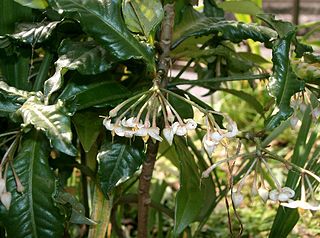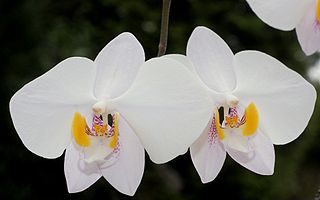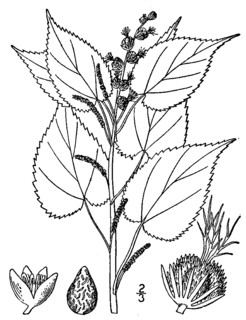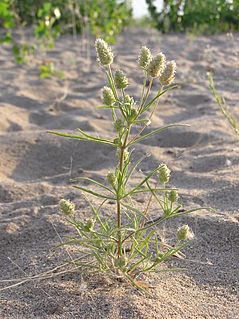
Ardisia is a genus of flowering plants in the family Primulaceae. It was in the former Myrsinaceae family now recognised as the myrsine sub-family Myrsinoideae. They are distributed in the Americas, Asia, Australia, and the Pacific Islands, mainly in the tropics. There are over 700 accepted species. One species, Ardisia japonica is one of the 50 fundamental herbs in traditional Chinese medicine.

Ardisia japonica, known as marlberry, is a species of Ardisia native to eastern Asia, in eastern China, Japan and Korea.

Ipomoea cairica is a vining, herbaceous, perennial plant with palmate leaves and large, showy white to lavender flowers. A species of morning glory, it has many common names, including mile-a-minute vine, Messina creeper, Cairo morning glory, coast morning glory and railroad creeper.

Ardisia elliptica is an evergreen tree, also known as the shoebutton ardisia, duck's eye and coralberry, native to the west coast of India, Sri Lanka, Indochina, Malaysia, Indonesia and New Guinea. It is a prolific reproducer which has made it a successful invasive species in other locations in the tropics where it has been introduced as a garden ornamental.

Ardisia humilis is a species of flowering plant in the genus Ardisia in the family Primulaceae, native to southeastern Asia in southern China, the Philippines, and Vietnam.

Kleinhovia hospita is an evergreen, tropical tree native to Indonesia, Malaysia and other parts of tropical Asia. It is monotypic, being the only species in the genus Kleinhovia.

Mangifera zeylanica or “Sri Lanka wild mango” is a wild species of mango tree endemic to Sri Lanka. This stately tree is the tallest member of the mango genus, Mangifera, and one of the two tallest trees in the family Anacardiaceae. The mango fruits are edible and have an excellent taste. It is called "aetamba" (ඇටඹ) or "wal amba" in Sinhala and “kaddu-ma” in Tamil. The well-known British botanist and explorer Joseph Dalton Hooker first described the tree in 1876.

Brunfelsia pauciflora is a species of flowering plant in the family Solanaceae, the nightshades. It is endemic to Brazil, and it is grown in cultivation. A shrubby perennial plant grown in gardens, its common names include yesterday-today-and-tomorrow, morning-noon-and-night, Kiss Me Quick, and Brazil raintree.

Phalaenopsis philippinensis is an endemic species of orchid found from Luzon island in the Philippines.

Hypericum mutilum is a species of St. John's wort known by the common name dwarf St. John's wort. It is native to parts of North America and is present in other parts as an introduced species. It is an annual or perennial herb taking a multibranched erect form up to about 60 centimeters tall. The oval green leaves are one or two centimeters long and are covered in tiny glands. The inflorescence is a compound cyme of tiny flowers. H. mutilum subsp. mutilum and subsp. boreale have a diploid number of 16, and H. mutilum subsp. boreale can have a diploid number of 18.

Artocarpus hirsutus, commonly known as wild jack, is a tropical evergreen tree species that is native to India, primarily in Kerala, but also in Karnataka, Maharashtra and Tamil Nadu, where it prefers moist, deciduous to partially evergreen woodlands.

Ardisia escallonioides, the Island marlberry, is a plant species native to the West Indies and neighboring areas. It has been reported from Barbados, Bermuda, the Dominican Republic, Cuba, Mexico, Belize, Guatemala and Florida.

Acalypha ostryifolia, sometimes spelled ostryaefolia, is a plant in the family Euphorbiaceae and is commonly known as hophornbeam copperleaf, hornbeam copperleaf, or pineland threeseed mercury, is an annual herb of the copperleaf genus Acalypha. It is a native of North and Central America and is generally considered a weed.

Hakea elliptica, commonly known as the oval-leaf hakea, is a shrub in the family Proteacea and is endemic to Western Australia. A fast growing adaptable species with ornamental wavy leaves, golden bronze new growth and an abundance of showy white flowers. A good wildlife habitat due to its dense form with foliage to ground level.

Hakea invaginata is a shrub in the family Proteacea and is endemic to Western Australia. It has purplish-pink flowers, smooth needle-shaped leaves and the branchlets are thickly covered in hairs.

Cadaba farinosa is a 2–8 m (6.6–26.2 ft) high evergreen shrub or small tree that belongs to the caper family. It has simple ovate leaves with entire margins, zygomorphic, spidery, greenish, yellowish, whitish or pinkish flowers, and is covered in powdery hairs or scales, particularly the younger parts. It can be found in a zone from Senegal to India between the desert and the savanna.
Hypericum cuisinii is a perennial herb in the genus Hypericum, in the section Adenosepalum. The herb has pale yellow flowers and occurs in Greece and Turkey.

Prunus himalayana, called jyokun shin in Tibetan and 喜马拉雅臭樱 in Chinese, is a species of Prunus native to Nepal, Bhutan, Sikkim and Tibet. It prefers to grow 2,800 to 4,200 m above sea level in the Himalayas. As Maddenia himalaica it was the type species for the now unrecognized genus Maddenia.

Plantago indica, commonly known as branched plantain, sand plantain, or black psyllium, is a flowering plant in the plantain family Plantaginaceae, and is one of a few species in the Plantago genus under the common name psyllium. The plant is native to parts of Africa, Europe, Russia, and Asia, and has been naturalized in many other areas such as Australia and North America. The plant can be found mostly in dry inland areas, such as those that are sandy, and has also naturalized on roadsides and in meadows. The plant is not used broadly as a food source, but has been cultivated for its seeds which serve a medicinal use as a laxative.
Spathiostemon moniliformis is a plant that can grow as a shrub or a tree in the Euphorbiaceae family, Acalypheae tribe. It is endemic to southern/peninsular Thailand.


















